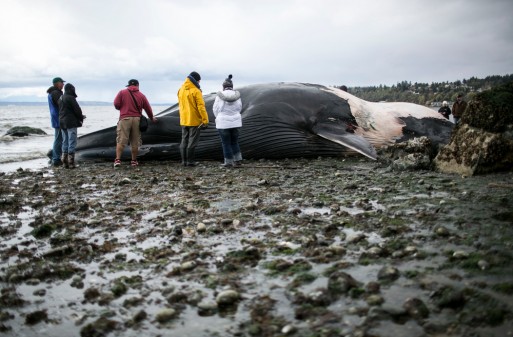
(Saturday photos by Nick Adams for WSB, unless otherwise credited)
Dead or alive, an endangered fin whale is a rare sight in Puget Sound. So the one that turned up dead at Seahurst Park in Burien on Saturday (here’s our previous report) was something Jesavel Garcia said she would tell her grandchildren about – the reason why she took a self-portrait with the whale in the background. She had company:

And for researchers, it was quite a sight as well:

Up close, you could see its baleen:

(Photo by David Hutchinson)
That photo is courtesy of David Hutchinson, who was one of the volunteers from West Seattle-based Seal Sitters who went to the scene; Robin Lindsey has written about it on the group’s Blubberblog site. More photos and information ahead – including troubled waters for funding of response and research in cases like this:
As mentioned in our Saturday report, today marks exactly three years to the day since a similar scene started unfolding on the beach in West Seattle’s southwesternmost neighborhood, The Arroyos, after a gray whale died offshore. This is just a few miles south:

A situation like this is known technically as a stranding, whether the animal lives or dies. Like the gray-whale stranding in 2010, this one also is being investigated by Cascadia Research (its preliminary report is here), which made the early determination that it died because it was hit by a ship, and that what turned up at Seahurst was only part of a fin whale that when alive had been up to 65 feet long – that’s as long as a six-story building is tall; here’s some hint at the scale of the 52-foot section found at Seahurst:

They are the second largest creatures in the sea; this is the 10th one stranded in Washington in the past 11 years, according to the Cascadia site, and ship strikes are blamed for eight of those deaths.

Despite the tragedy of the scene, the majesty remained. Touching one of the whale’s fins, Christina Pfeiffer told Nick, “We were really interested in coming to see it, we love whales and are nursing students.”

The whale had died up to a week earlier, according to the Cascadia Research report. As noted in that report and Robin Lindsey’s Seal Sitters writeup, responders also came from the federally funded stranding-network program – and Robin had reported just Friday that the proposed federal budget eliminates that funding. If you are concerned, the time to contact Congress is now.
In Robin’s Saturday night report, she also mentioned steps that can be taken to lessen the chance of ship strikes – something noted in this video shared on the WSB Facebook page by Peter Han:
We will be following up today on what will happen next; you might recall that the 2010 gray whale in The Arroyos eventually was towed to a remote beach where it was left to decompose until its bones remained, and they are on display at the Highline College MAST center in Redondo (here’s our report on the exhibit’s opening).

| 22 COMMENTS